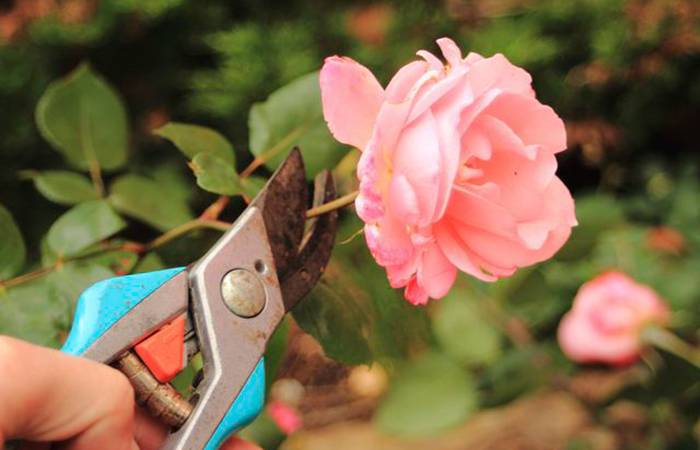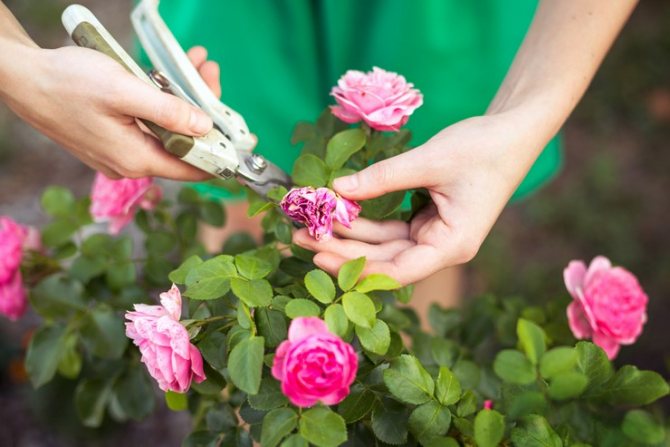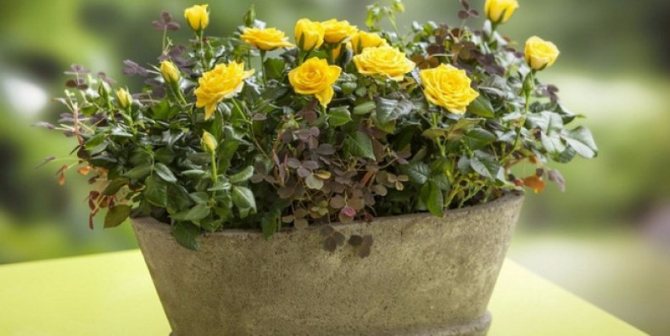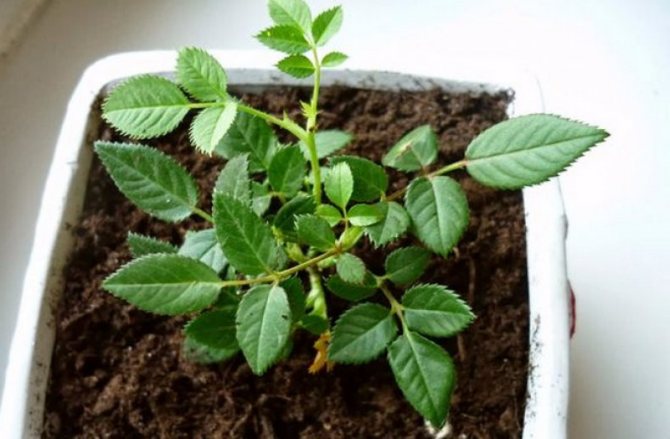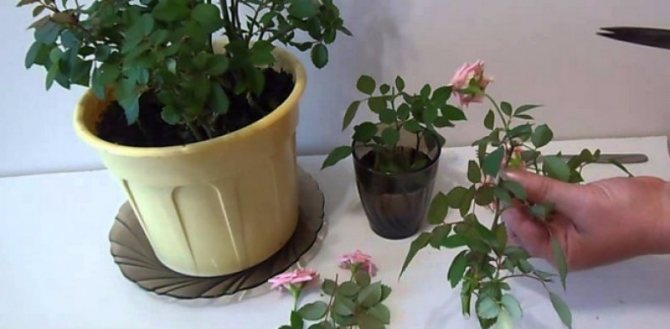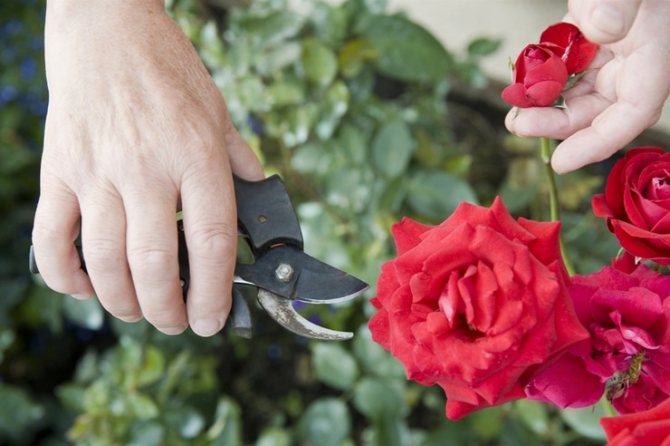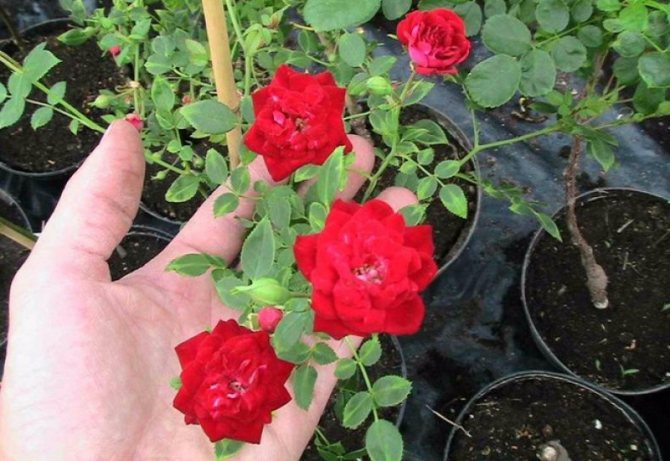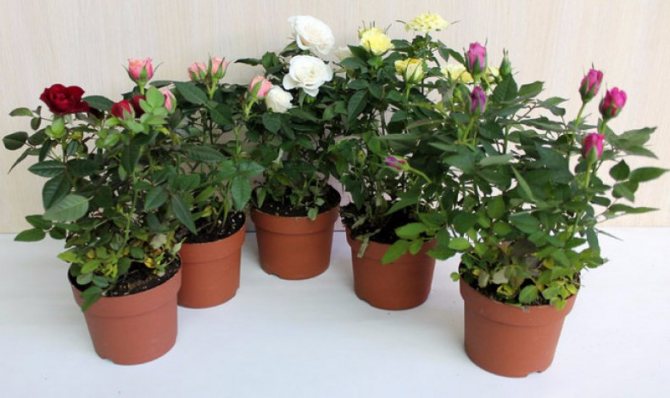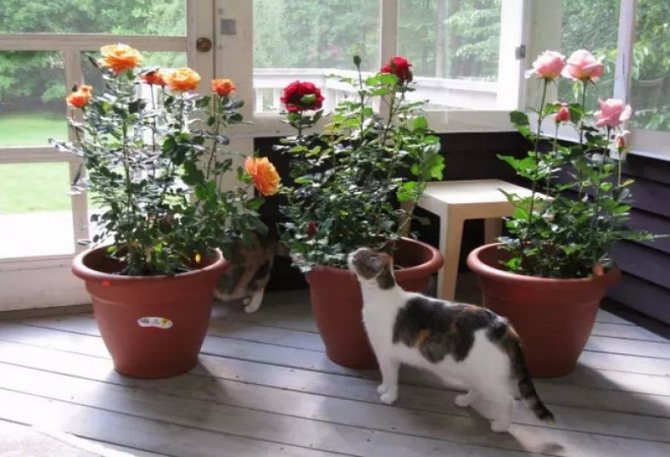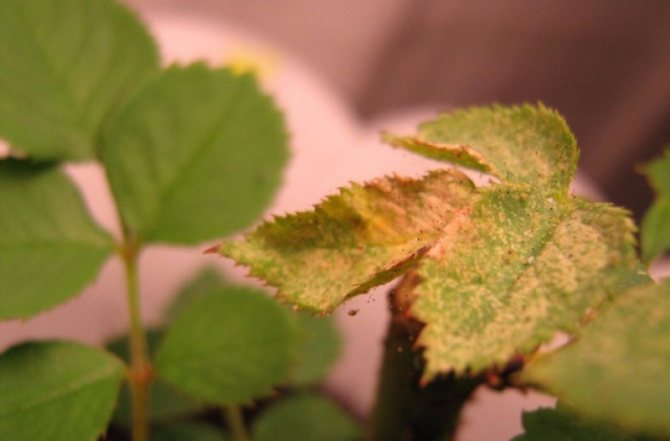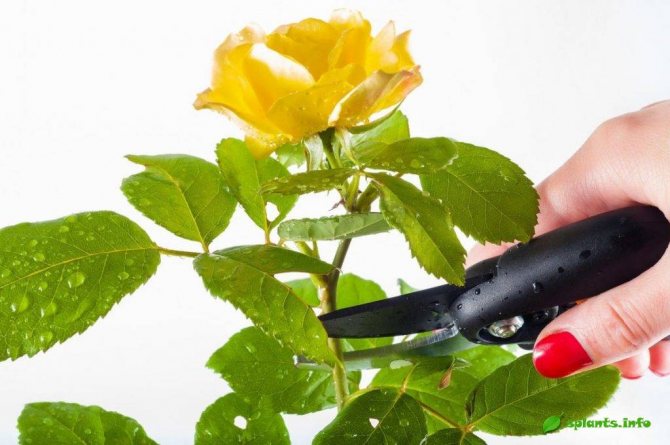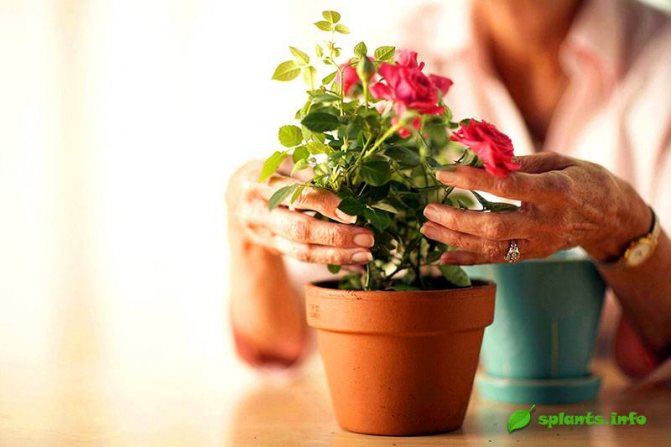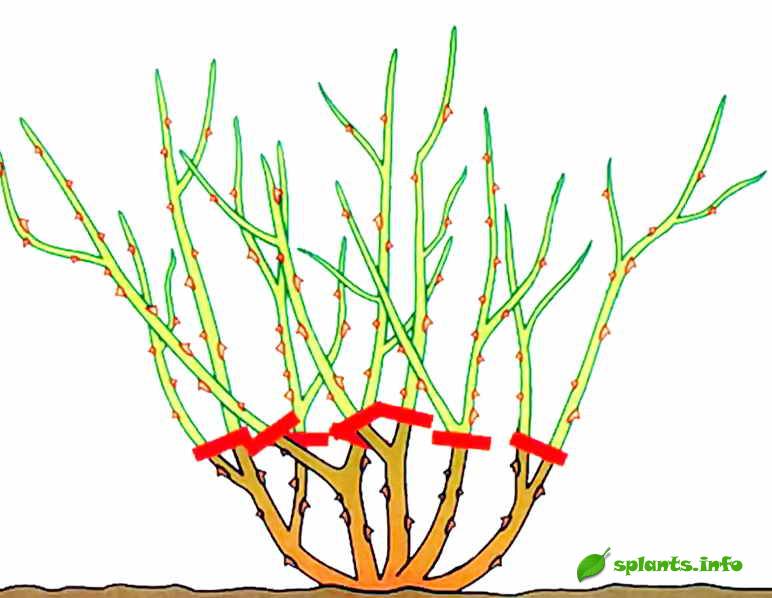Indoor roses are so popular that they began to be perceived as a kind of seasonal decoration or a festive accent. Many growers simply throw away the rose after flowering, although even in a potted format, it remains a full-fledged shrub and can delight us for many years. In addition to the cool wintering, roses only need proper care to re-bloom. The key factor is correct pruning, which is almost the same as pruning garden princesses.
Pruning a room rose.
Indoor roses cannot be called difficult to grow plants. It's just that you need to carefully select the temperature conditions for them and take a responsible approach to care. If you surround your roses with care, they will bloom relentlessly and almost constantly.
For indoor roses, watering, and feeding, and access to fresh air, and frequent examinations are important. But if all other basic care items are "responsible" for the health and strength of plants, then one of the procedures is the key to its abundant and continuous flowering.
Pruning is the secret behind the luxurious flowering of potted roses. In this, miniature copies of garden ladies (which are indoor roses) are no different from any other varietal roses.
For indoor roses, you need to carry out three types of pruning:
- Regular, annual pruning for formation and flowering.
- Regulatory pruning to tackle weak or out-of-the-line shoots.
- Seasonal pruning, which is the removal of withering parts of the plant.
Without exception, all indoor roses, regardless of their origin and class, perfectly tolerate even the strongest pruning and allow shaping. Both miniature, and floribunda, and Chinese varieties are pruned according to the general rules..
When pruning indoor roses, it is very important to comply with all sanitary and hygienic standards:
- use only sharp tools, and best of all - special pruners for pruning shrubs;
- make sure the tools are clean and treat the working surfaces with disinfectants;
- process all sections at once with protective equipment.
Whatever pruning on roses is discussed, even in a room format, the cuts must be done correctly, carefully checking the location of the buds. For indoor roses, pruning is carried out only above the buds, as close as possible, but still leaving a part of the trunk about 0.5 cm long to eliminate the risk of damage to the bud itself. Damaged shoots are trimmed to healthy tissue. The cut is done only at an angle, from the kidney.
Is it absolutely necessary?
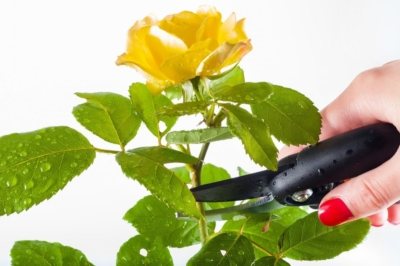
The procedure is vital for your rose, because it contributes to its development and rejuvenation.
There are three types of plant pruning.:
- Pruning weak shoots that go beyond the outline. It is needed for full growth.
- Formative pruning. It promotes flowering and is held every year.
- Pruning of wilting and old shoots is carried out every season.
Why is it needed
Any experienced florist will say that it is imperative to cut roses for the winter, both garden roses growing in their summer cottage and home ones. At the same time, pruning flowers in autumn is just as important as in spring.
Spring pruning allows you to refine the bush, shape it correctly, remove branches that have been broken and lost during the winter, that is, it is mainly decorative in nature. Cutting rose bushes for the winter means making them stronger, healthier, not afraid of frost. This type of pruning provides buds and stems with sufficient sunlight and air, and encourages the emergence of new buds and shoots. Flowers from such buds are large, and the shoots are strong.
In addition, if the pruning of bushes for the winter is done correctly, then this contributes to:
- development and strengthening of roots;
- early growth;
- the formation of a large number of kidneys;
- resistance to various infectious diseases;
- accumulation of nutrients.
There are both general rules for garden (whether climbing or others) and for indoor (including Chinese hibiscus) roses about how to cut them for the winter, and their own characteristics for these types of roses.
Features of pruning in spring, summer, autumn and winter
The main pruning takes place in late winter - early spring. Then, when the flower begins to actively grow. This is the time to get rid of dried leaves and stems. Rose pruning also depends on the seasons. The houseplant is also affected by the change of seasons.
- In the spring branches damaged by dry air and pests are cut off. Unaffected branches simply need to be shortened to stimulate flowering.
- In summer pruning of dead wood is important (dry flowers, branches, leaves). It is necessary to monitor the appearance of unnecessary shoots and cut them off. They can cause fungal infections. To stimulate new flowering, summer pruning is carried out in early August, but only for those plants that bloom several times a year. Indoor rose periodically should be outdoors.
- In autumn cut off the top and wilted flowers. In some varieties, secondary flowering is stimulated. Pruning during this period is especially useful: there is a preparation of nutrients for the next season and nutrition of the root system.
- Winter pruning. To stimulate growth and flowering, the plant needs pruning for the winter. It is carried out after the flower has dropped its leaves. Those roses that need to be covered must go through this procedure. During such pruning, even before frost, the stems are shortened and unripe shoots are removed. In order not to infect the flower with fungal diseases, you will need a sharp, sterile knife. You need to cut off the branches, leaving 3-4 buds.
The main winter pruning is carried out at the end of February, when the buds have just begun to swell. At this time, the room should be cool. Then the injury will not harm, since the growth process slows down.
Timing
First of all, you need to decide what is the purpose of pruning a rose bush. You need to know that:
- Withering flowers should be trimmed as soon as they appear. Then the rose will devote its strength to the development of new buds and will bloom longer.
- During the transition to a period of calm, when the rose has completely bloomed, it is appropriate to remove diseased, weak, dry shoots and leaves. They will no longer develop, and at this time the bush can be cleaned.
- In late summer or early autumn, cuttings can be cut for propagation. Before winter, they will still have time to take root, and in spring they will actively grow.
- In late winter - early spring, it is best to prune the rose, forming the crown, as well as to thin out and rejuvenate the plant. By pruning before the buds begin to develop, you can speed up the onset of flowering and make the plant stronger and more beautiful.
What parts of the houseplant are removed?
It is important to know which parts of the plant should be removed without damaging the home rose.:


- wild stems growing from the base;
- fresh shoots that will not survive the cold;
- branches growing towards the stem of the bush;
- dried twigs and flowers;
- old shoots that are more than three years old.
Features of growing a home rose
Indoor rose blooms in spring and summer, at this time it needs light and good watering. For abundant flowering, she definitely needs a dormant period, which is best organized in winter.
This houseplant tolerates low temperatures well, but is demanding on air and soil moisture. She is very light-requiring, but direct sunlight can harm her. Rose loves to "swim", so you should follow the regime of water procedures. She needs fresh air all year round.
Important!
After the purchase, do not rush to transplant it. It is better to do this in two weeks, then it will better adapt to new conditions.
When can a part of a plant be removed and when not?
- When flowering once a year, in the fall the rose produces decorative fruits, in this case the flowers of the plant are not removed.
- In summer, shoot growth is undesirable. It is stimulated by pruning withered flowers. Therefore, the procedure does not need to be carried out at this time of the year.
- It is necessary to remove the wild growth growing at the base of the rose. If you do not carry out the pruning procedure, this can lead to the death of the plant.
- Prune branches and remove leaves in the fall. This will help the plant not to become infected with fungal diseases.
Additional and seasonal treatments
The correct pruning for indoor roses starts at the flowering stage. As with garden beauties, fruiting in indoor roses negatively affects the duration of flowering and its characteristics. Bushes must be regularly inspected and the withering flowers must be removed from the plant constantly. Such "cleaning" will allow not only to prolong flowering, but will also give an opportunity to admire the flawless bushes in pots, which are far from being decorated with the look of withering petals.
Basic seasonal treatments during flowering:
1. As soon as the flowers wither on the rose, all the faded parts of the shoots are shortened to the first full-fledged leaf (five-leafed leaf) or to the first full-fledged bud looking outward. Pruning over the bud is carried out according to the same rules as the main pruning on indoor roses.
2. If you want to achieve permanent flowering from the rose, you can cut the stem to the fifth bud after the flower has fully opened, thereby stimulating the growth of new shoots and buds. Each new shoot during the entire growing period is shortened in the same way as with the main pruning. This option is laborious and does not always bring the desired result; in conditions of reduced daylight hours, the rose will still stop flowering, so it is better to simply remove faded inflorescences in the usual way and not combine pruning and flowering.
3. As part of additional measures, remember to remove dry or damaged parts. It is also better to cut dry or starting to dry out leaves or twigs, without waiting for the spring sanitary cleaning.
It is better to supplement the last trimmings of faded inflorescences with sanitary cleaning - removing damaged, weak, dry, unproductive or thickening shoots. By thinning and leaving only strong, healthy twigs for the winter, the risk of spreading diseases and pests is reduced. It is not necessary to carry out sanitary pruning after flowering; it may well be combined with the main one. And in this matter, it is better to focus on your preferences and capabilities.
Step-by-step pruning instructions
For the procedure you will need:
- garden gloves;
- sharp and sterile pruning shears;
- waste basket.


- Peduncle... Peduncle pruning is required when the plant has faded and does not have enough strength for future flowering.
With the help of a pruner, we remove those flowers, the petals of which crumble at the slightest movement, and the bud is bent down. Stem... It is necessary to remove dark and dull stems of the plant. If the stem is only half damaged, trim it slightly above the orbit.
The movement of air, which is important for the plant, can be impeded by weak and thin shoots growing towards the stem of the bush.It needs to be cut off at the base.
- Leaves... In the fall and spring seasons, the leaves are pruned for health purposes. This contributes to the lush flowering of the home beauty.
- Arrows... Cut flower arrows without leaves when they are weak. If the flower is too heavy for the stem, the insoles must be removed as well.
Next is a visual video with a room rose trimming:
Lighting, temperature and humidity
Like garden roses, their dwarf relatives are very fond of good lighting, but not the south side, where the bush will quickly fade and the leaves will fade. Such windows should be shaded in the summer, and, if possible, place the flowerpot in the south-west. But in winter, when the daylight hours are short, the rose needs additional lighting with lamps.
The comfortable temperature for a dwarf rose depends on the time of year and the period of development:
- in spring and summer - no higher than 25 degrees Celsius;
- from mid-autumn to the end of winter - from 5 to 8 degrees Celsius.
Dry room air is destructive for roses, so you should spray the bushes every day, and put a container of water next to it.
Leaving for the first time
For details on what kind of care is needed at home for a room rose, read here, and from this article you will learn how to take care of a flower in the winter.
What kind of soil does a dwarf rose like?
In principle, the first two weeks after purchasing a flower, it is not necessary to transplant it. The rose should be given time to get used to the new, homely, climate. Some growers generally do not advise replanting the purchased plant until the flowering ends or until it “grows” from an old flowerpot. But if there is a need for an urgent replacement of soil or transshipment, this must be done after the adaptation of the rose.
In the future, it should be transplanted in the spring or at the end of summer as the bush grows, picking up a flowerpot 2-3 cm wider and 5 cm higher than the previous one.
The soil can be purchased at the store (ready-made substrate), or you can make it yourself by mixing:
- 1 piece of land from the garden;
- 2 parts of humus and peat;
- a handful of coarse sand.
Possible errors and their consequences


Incorrect pruning of a room rose is a failure to follow simple rules for caring for a plant during this procedure. There are a few general points to keep in mind.:
- Sharp and clean instrument. Disinfection with a solution of copper sulfate or a strong solution of potassium permanganate is mandatory.
- Be sure to work in gardening gloves so as not to damage the skin.
- We make the cut at an angle so that the water flows down when watering.
- The bud should look outward of the bush, not inward. You need to trim it 1 cm below the kidney.
- After the procedure, we must process the cut.
Incorrect pruning can lead to a deterioration in the quality and a decrease in the number of flowers, a loss of decorativeness of the plant. Sometimes this even leads to its death (you can find out how to prevent the death of a flower and revive a rose at home here).
One more a common pruning mistake of this period is insufficient attention to blind shoots... If such shoots are cut off in time, they will turn into blooming.
Proper care and attention to your home rose will provide a healthy and lush bloom, which will surely delight you with its decorativeness and beauty.
What do you need to properly prune roses?
Pruner, knife, water, soil mix.To begin with, you must determine which variety your indoor rose belongs to, because the method and frequency of pruning depends on this. So a tea rose is usually cut into 3 eyes. The main point of pruning roses is as follows: to stimulate the growth of lateral shoots, if the shoots of the rose are strongly elongated and cease to bush. Each grower shapes the silhouette of the bush to his taste.
It is best to prune the rose in March-April, when the flower has not yet fully woken up and the buds have not yet blossomed. For the information of amateur flower growers: timely pruning speeds up the onset of flowering of a room rose.
Useful video
We offer you to watch an informative video about pruning a room rose:
If you find an error, please select a piece of text and press Ctrl + Enter.
When I need to give someone a bouquet, I try to buy not cut flowers, but roses in a pot. Letting the plants take root in the house (it takes 10-15 days), I cut off long shoots with flowers and make a bouquet of them for a gift, and leave a pot of stumps for myself. Time passes, and it again grows overgrown with green shoots, and then flowers ...
Rose transplant
To get a potted rose, it must be planted in pots from the soil in August. Then the transplanted roses have time to take root before winter and by the spring of next year they will bloom. If transplanted in the spring, they will take root throughout the summer, and will bloom only the next year.
For planting homemade roses, take small flowerpots, because in large pots, the soil dries out much more slowly and can sour. From this, the roots can rot. In addition, in large pots, the home rose "fattens": it gives few flowers and many leaves. Try to grow indoor roses in small pots, often replanting them in nutrient mixtures and feeding them with fertilizers.
When replanting a home rose during the growing period, try not to break the earthy ball so as not to damage the root system. So roses can be replanted all summer long. In order for the plant to take root better, it is placed in the shade for five to seven days and watered moderately.
Why does a rose need pruning
To prevent a rose in a pot from getting sick, it must be grown at the correct temperature (20 degrees in summer, 10 in winter), not kept in musty rooms, watered with settled water and fed with special fertilizers. But in order for the plant to bloom regularly, the bush must be cut off at least regularly. In this, the indoor rose does not differ from its garden “sister”, which also needs frequent “haircuts”.


Any roses (Chinese, mini, floribunda) tolerate this procedure perfectly. All bushes are cut in the same way.
But of course, you don't need to work anyhow:
- use only a razor-sharp tool (blunt scissors will grind the stem, which will then rot);
- before starting work, wipe the pruner with alcohol or dip it in boiling water - even plants are afraid when bacteria are introduced into the "wounds";
- after the cut is made, it should be processed - not with brilliant green, of course, but rubbing with crushed coal or even garden pitch is desirable.
It is also important to make a cut in the right place: above the kidney, 0.5 cm from it (you should not be closer - you can damage the kidney). Something like this:


If this is a therapeutic pruning, that is, you prune a damaged (bad, worn out broken, rotten, dry) shoot, cut to healthy tissue, at an angle, from the bud.
Three types of pruning for an indoor flower
- Main (regular, annual). It is thanks to her that the bush will bloom magnificently. In addition, by such pruning, we form it, preventing it from turning into several long, thin "sticks" topped with just a couple of leaves.
- Regulatory (sanitary). Removal of defective (weak or ugly sticking out of the bush) twigs.
- Seasonal (including for the winter).When the bush finishes flowering, the buds must be removed. This is important both for setting new branches and for the health of the flower as a whole.
How to prune roses?
For pruning, take only sharp tools, otherwise the cut will be torn, and this can damage the plant. Make the cut 5 millimeters above the kidney and at a 45-degree angle towards the eye.
Start cropping with thinning, so you can see what needs to be tweaked and where. First of all, old, damaged or diseased shoots are removed, then, if necessary, we remove the shoots growing inside the bush. Shoots that do not have an apical bud are also removed.
Due to the lack of free time and the desire for indoor flowers, I practically do not. But recently I was presented with an amazing indoor rose. A compact bush with bright yellow flowers immediately won my love, but I'm afraid that it will not disappear. Tell me how to care for dwarf roses in pots so that the flower grows well and blooms profusely?
Dwarf roses, unlike garden roses, not only have a more compact appearance, making them easy to care for, but are also able to delight with their flowering much longer.
What kind of care is needed for dwarf roses in a pot so that the plants feel good and delight the hostess with long and abundant flowering? Everything is quite simple and you don't need to invent anything new, the main thing is to give the beauty a little attention and provide comfortable conditions:
- pick up nutrient soil;
- choose a lighted place;
- regulate the temperature and humidity of the air;
- water in a timely manner;
- periodically feed and trim.
Basic trimming
Your task is to shorten old shoots, forcing them to bush and grow new branches, on which buds will appear soon. On the shoots of last year, flowers almost do not bloom.
It is necessary to prune when the bush is just beginning to wake up after a dormant period, but has not yet managed to enter the growth phase. This mainly occurs in February or the first weeks of March, that is, when the daylight hours already lasts 10 hours or longer. But it is better to look at the buds: they should not swell yet, but they will already be visible on the shoots (growers say that the buds have already “nailed”). You need to see them in order to properly cut the branches.
Do not hurry! If you cut the bush ahead of time (that is, when there is still little light, and you do not use the phytolamp), fresh branches will grow weak and rare. This means that they will give you less flowers and even leaves.
If you miss the moment and cut the bush too late (that is, the buds will already wake up and begin to burst, increasing the leaves), the rose will endure pruning more painfully. Still, she has already spent a lot of energy on awakening the kidneys! As a result, this bush will not develop as well as we would like.
Work step by step
- Start with regulatory pruning: clean dry, diseased, broken twigs to healthy tissue. If you do not see buds on the shoot, there is no point in fighting for it, so cut it to the base of the bush. The same fate should await weak, too thin branches.
- Now start shaping the bush. Remove shoots without an upper central bud (called blinds), very crooked, growing deeper into the bush. If two shoots intersect, cut off one of them (the one that looks weaker). In addition, if two branches grow from one bud, one of them must be removed.
- If you are a beginner and are afraid to harm the shrub, just halve each shoot, that is, cut it in the center (half the length).
- Experienced flower growers do it a little differently. On each shoot, you need to leave 3-5 buds. The small-flowered variety can be cut below the large-flowered variety. If the shoot is weak, leave it no more than 3 buds, and if it is thick and strong, you can leave 6.No matter how many weak branches a rose has, which "chink" under the root, on any bush there should be 4-5 skeletal, basic shoots from 10 to 15 cm tall.
- When pruning, you can dictate the shape of the bush. Although it is worth looking at the type of plant. Bengal (Chinese) rose and floribunda can be designed as you like - under an ellipse, cone, sphere or in the form of a "flat" bush. And miniature (mini) varieties are best formed only with a rounded shape. If you remember what the bush was like when you bought it, it's best to stick to this particular shape. By the way, it is better to shape the bush not in one cut, but in several, stretching this procedure for a couple of years.
Pruning rules
When pruning a room rose bush, you must take into account that:
- Pruning should be done with a garden pruner or a sharp knife. The cut must be done at an angle.
- First of all, you should remove all weak and small shoots growing inside the bush, and then proceed to the formation of the crown as a whole. This will prevent thickening and give the bush a beautiful shape.
- Each shoot should have at least 3 buds, on a large plant and thick branches - about 6.
- In order to grow large flowers, it is required to remove the side shoots, leaving the tops. For the bush to be lush, but with small flowers - on the contrary.
- The cut should be made above the kidney turned outward and 5 mm higher along the trunk so as not to damage the kidney.
- To form a beautiful flowering bush, you should remove all shoots that end in a blind bud.
After pruning, it is better to transfer the plant to a cool place (with a temperature of about + 10 ... + 12 degrees). As soon as the first young leaves appear, it is necessary to provide the rose with more light and the temperature can be gradually increased.
I first got acquainted with a room rose back in the distant 90s. During a labor lesson, our class was sent to one of the school greenhouses to master garden work, and there I saw two tall bushes of blooming roses. They were unusually beautiful, double flowers 5-7 cm in size gave off a pleasant aroma and had soft pink and cream shades. They say that if you steal a sprout, it will surely take root. Naturally, like any child, I could not resist and pinched off a twig from each bush, hastily slipping them into the pocket of my school apron. Arriving home after school, I stuck them into the first pot of my mother's standing on the window and intuitively, to create a greenhouse effect, covered it with a half-liter jar on top.
At that time, there was no Internet, I also did not have an encyclopedia of indoor plants, I was not particularly fond of floriculture, therefore, referring to "maybe they will take root", I can say I forgot about my wards. I did not follow the development process at all, I watered the flowerpot along with the rest of the flowers once a week. Imagine my surprise when, after a while, I discovered through the glass with droplets of condensation that both pink twigs released side bright green leaves. My joy knew no bounds, because only cut flowers were on the free sale, there was no abundance of potted culture as at the moment, at that time was not observed. Amateur flower growers exchanged small shoots or cuttings from hand to hand.
The subtleties of pruning a flowering and fading bush
Seasonal pruning is also very important. Fruiting, that is, the setting of seeds after the buds have faded, greatly weakens the bush, so it should not be allowed before.
A shoot with a limp flower is cut to the first full-fledged bud, wrapped outward, or to the first full-fledged leaf (having five "mini-leaves"). The logic behind this trimming is shown in this figure:


You can not wait, and "otchikat" shoots immediately after the opening of the flower. It will bloom beautifully in a vase, and your bush will have more time to grow new branches. But this can only be done in spring or early summer.If the rose pleases with flowers in the fall, it is better to leave them on the bush - in a short time for new shoots will still not appear.
By the way! The first pruning of a flowering bush should be done immediately after purchase, letting it stand in the house for about 2 weeks (acclimatization). Moreover, it must be transplanted into fresh soil. The transplant will save him from the transport, empty soil, pumped up with various chemicals. And the accompanying pruning will help save energy by rooting better in a new pot.
The last pruning (for the winter) is best combined with a sanitary one. Do not leave dry, diseased twigs on the bush. Remove problematic leaves too. Although if the bush looks healthy, sanitary pruning can be left in the spring.
What to do with cut branches?
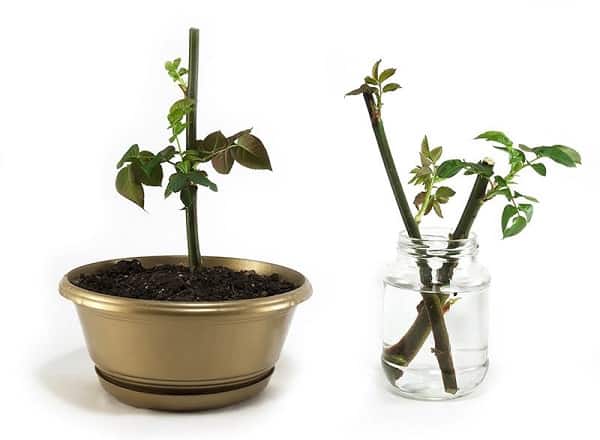

It is a pity to throw away healthy twigs, both in the spring and when removing dull flowers. You can do this:
- If there is a flower, remove it with a few centimeters of the stem.
- Cut off the two lower leaves on the cutting as well (they can start to rot, killing the plant).
- Place the cutting in water (but not deeply deepening - a maximum of 2 cm) and keep it in a bright, warm place. A room window sill is perfect for this.
- When the twig grows roots, it can be planted in a pot, in the soil for roses. First, you can attach three cuttings to one pot, placing them in a triangle. Thanks to this, the bush will turn out more magnificent. But when the roses grow, with the subsequent planned transplant, it will be better to transfer the plants to separate pots.
By the way, you can also stick the stalk directly into the pot to the mother bush. It will take root there too.
Cuttings can also be rooted in a light sandy substrate. For example, like this:
In addition, you can use the "revolutionary" method - rooting a cut of a room rose in a potato:
When growing a room rose, it is important to form it correctly. Pruning can be short, medium or long, apical. The latter should be carried out before the onset of winter: sluggish, weak, diseased shoots are removed. The procedure will help to form a bush, stimulate the second flowering, active growth of foliage, new branches.
Transplanting and propagating roses at home.
It is advisable to transplant the mother bush in the spring no more than once every two years, you can be content with transshipment. To do this, you need to buy a flowerpot slightly larger than the previous one, pour drainage on the bottom, send an earthen lump from the root to the center of the flowerpot and fill fresh specialized soil around the root system. During transplantation, the bottom of the flowerpot must be constantly tapped so that the soil mixture is well compacted and there are no voids in the pot. I want to draw your attention to the fact that the substrate purchased for transplanting in the cold season must be at room temperature, otherwise the roots of the rose may suffer, which will later affect the plant itself.
If you want to propagate your rose, then with the next pruning, cut the cuttings with pruning shears ideally with two or three buds, but always with leaves, and put them in boiled water for a while with one tablet of activated carbon, so that the water does not turn sour in the future. There is no need to change the water, just add it as it evaporates. For rapid root formation, any root former can be added to the water with cuttings, for example, Root. The emergence of new roots occurs within 2 - 4 weeks. The best time for such a procedure is late summer, early autumn. When the cuttings have their own roots, you can plant them in separate pots, the soil can be used for flowering plants.
Purpose of pruning
The procedure for removing excess shoots before winter is one of the most important for indoor roses. Its main advantages:
- Helps to form a room rose, to give it a graceful look.
- Stimulates abundant annual flowering and new shoot development.A pruned plant accumulates nutrients, which subsequently help to grow in the spring.
- Promotes better root development.
- Helps to avoid unattractive intertwining of branches.
- You can get rid of overgrown, weak, dead branches that are quickly attacked by pests, and they are also affected by diseases.
- Wintering of indoor roses after pruning takes place without infection with infections, fungi: weak, diseased shoots are removed, exceptionally healthy, strong parts are left.


Removing dead buds
Decide on the type of fall pruning. It happens:
- Sanitary - especially useful for young bushes. If you missed the time before winter, then it is important to carry out the procedure in the spring or any other time of the year. The goal of sanitary pruning is to get rid of dead, damaged branches.
- Regulatory - forms a room rose, shoots knocking out of the contours are removed, the weakest shoots are cut off slightly above the main branch.
- Regular, annual or seasonal - needed to create a beautiful crown, stimulate abundant flowering.
- Apical - the top is removed to stimulate the growth of a room rose in breadth.
- Anti-aging - considered radical, carried out at intervals of 2-3 years, helps to restore vitality to too thick and high bushes. Sick, dry processes are removed, long ones are shortened.
In addition, the procedure for removing shoots is divided into three types. Choose a suitable one based on the length of the stem, the branching of the bush. So, pruning a home rose can be:
- short - relevant for small-flowered, polyanthus varieties or springtime, the branches are shortened, leaving 2-3 buds;
- average - the most common, considered summer, but can be carried out before winter, applicable for all varieties, except for curly, ground cover, branches are shortened to 5-7 buds, the height of a room rose is left up to 35 cm;
- long - recommended before the onset of winter, relevant when the buds are located on the upper part of the shoots, ideal for large-flowered varieties, the branches are slightly shortened.
Pros and cons of autumn pruning roses
Benefits of Autumn Pruning:
- It is more convenient to cover the cut plant for the winter.
- The plant accumulates nutrients, they will help it develop in the spring.
- The growth of new shoots is increasing.
- The root system develops better.
- The bookmark of the number of peduncles is increasing.
- Plants are better protected from infection by infections, fungi.
Minus autumn pruning
- stimulating the growth of dormant kidneys if the average temperature at night rises to above zero. The buds that develop will not survive the subsequent frost. This threatens with illness, death of the escape.
The best time for circumcision
Top pruning for the winter is suitable for varieties that bloom several times a year. The procedure is carried out by removing wilted flowers, frail processes. Due to this, in some varieties, secondary flowering is stimulated, the development of young shoots. Working time - mid-August-early September. With late or prolonged flowering, this period may be shifted to October, November. Remember that the procedure is best done on the waxing moon.
Work with a room rose when the room is not hot, a little cool: this approach is explained by the fact that at low air temperatures, the flow of vital juices in the tissues of the culture slows down, the damage caused by injuries will be minimal.
Too radical pruning before winter is not recommended, because with a short daylight hours, new shoots do not develop, the plant spends a lot of effort on adaptation, is depleted, the time of cold weather may not survive. Correctly determine the time of work, it is advisable to carry it out after abundant flowering: the exception is the removal of dry buds, sick, obsolete branches.


Indoor roses
Pests and control measures.
Indoor roses are susceptible to the attack of a spider mite, it is almost impossible to prevent its appearance. In the room where the plants are located, the appearance of a spider mite is inevitable, therefore, every six months it is necessary to carry out preventive measures, periodically pickling plants from pests. It is advisable not to contain other indoor flowers in a room with roses or to place them away from roses so that the mite does not spread throughout the entire collection. As soon as you notice that the leaves of the rose begin to curl or shrink - this is the first signal for the appearance of a spider mite, you need to immediately start treating insects.
To do this, the shrubs are taken out into fresh air and abundantly treated from a spray bottle with an insecticide prepared in advance according to the instructions so that the solution gets into both the outer and the back of the leaves. With the remaining solution, you can spill the top layer of soil and wipe the window sills and shelves, where the roses were located before. Attention, during the use of any drugs, you must use personal protective equipment. Processing is carried out strictly with rubber gloves and a respiratory mask, not in windy weather. If the roses have been outdoors all summer, be sure to examine the plants for possible pests (aphids, spider mites, powdery mildew, thrips) before bringing them into the house, and treat them with appropriate preparations according to the instructions, for example
Correct pruning of a room rose
Work with exceptionally well-sharpened, thoroughly disinfected tools: treat them with a manganese solution. Cut off young, thin shoots with scissors, a garden knife, lignified branches - with a hacksaw, brush cutter, pruning shears (will cope with branches up to 2.5 cm in diameter). Be sure to wear heavy-duty protective gloves. Learn the rules for preparing indoor roses for the winter and the nuances of working with them:
- 7-14 days before work, water the bush as little as possible: this is necessary to slow down young shoots.
- To stop active flowering before winter, cut off the buds that appear.
- Fertilize your potted plant with phosphate-potassium fertilizers to help store more nutrients.
- Determine in advance the shape of the bush, its condition, thickness, height of the shoots. Based on this, choose the trim level. Remember that for small-flowered varieties, low pruning is preferable; for large-flowered varieties, leave 3-6 buds.
- Cut off shoots that are more than 3 years old, branches growing inside the bush, dry buds, flowers, leaves.
- If necessary, trim the damaged, affected parts of the central branches to healthy areas that are distinguished by a green bark, a white cut.
- Cut over the outer, developed, but unblown buds.
- Make slanting cuts, about 45 degrees.
- Be sure to leave 4-5 skeletal shoots: if necessary, cut them to 3-5 buds, leave a length of 10-15 cm.
- If the branches are large, well-developed, then 3-5 buds should remain on them. If there is no experience in growing indoor roses, then choose medium pruning (leave 5-7 buds each) or cut the shoots half their length. With this approach, you will avoid severe damage to the plant, its death.
- To keep the rose tall, slender, do not cut the upper shoots, remove only the side branches.
- Be sure to cut off dried buds, otherwise they will take away the strength that will be needed for a new flowering.
- Coat all sections with crushed charcoal or garden pitch: mix 6 parts of paraffin with 3 parts of rosin, 2 parts of mineral or vegetable oil, boil for 25-30 minutes, cool, stir.
- Spray the bush with a solution of copper sulfate: 100 g of the drug per 10 liters of water.


Correct cut of roses
Sanitary cleaning
So, you need to cut each variety.The procedure is similar to the formation of shrubs growing in the garden:
- First, remove damaged, dry, dead shoots: trim to healthy tissue. If there are no buds on the appendix, it is not alive, then there is no point in leaving even some part of it - cut it to the base.
- Remove all weak, elongated, thin, frail shoots to the base.
- Examine the plant carefully, remove the branches growing inside the bush, due to which the crown thickens.
- Get rid of severely twisted shoots, branches without upper central buds, intersecting shoots, excess twigs growing from a single bud.
Regulatory trim
After removing dry, damaged parts, start forming an ornamental bush. Decide on the shape: it can be strict, resemble a ball or a cone, it is possible to change the height and create flat, flattened shrubs. Before pruning a rose, consider its variety: each variety is "prone" to a particular shape. The basic rules for decorating room culture for the winter are as follows:
- Chinese, Bengali, or floribundas can be trimmed as you see fit.
- For miniature roses, conical, elliptical or spherical shapes are preferred.
- If you bought a bush with a certain shape, then while performing regular pruning, support it - cut off the escaping shoots in a timely manner.
- When creating a new form, stretch the formation process for several years: cut off a small part of the shoots annually, let the plant recover, thicken the crown qualitatively.
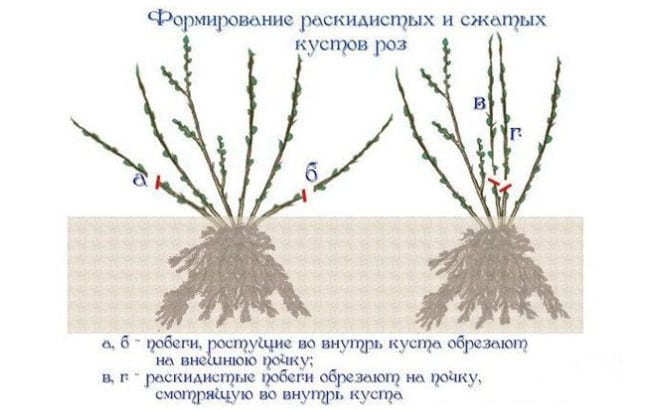

Formation of spreading and compressed rose bushes
Prepare a disinfected knife, scissors and other utensils, garden pitch, or crushed coal for wound care. Then follow these instructions:
- Determine the shape, height of the rose.
- After you have removed dry leaves, buds, wild growth, choose 3-5 strong green branches, use them as a base for the bush.
- Cut off excess shoots and their parts, leaving 3-7 buds. Remember the upper kidney must be outward.
- Remove, burn the garbage so that it does not become a source of plant disease in winter.
- Treat the wounds with garden varnish or crushed coal, spray the indoor rose with an antifungal agent.
What kind of roses are pruned in the fall?
Floribunda
In this species, flower buds are placed on the shoots of this year. For pruning a bush, two pruning methods are recommended. Such pruning
called
combined
.
Some of the branches are cut, leaving up to 10 buds, this pruning ensures early flowering. The remaining branches are greatly shortened, leaving 3-5 buds, thereby causing the growth of new shoots, they will bloom later.
Polyanthus roses
Mature shrubs of this species should have 7-8 main branches. The rest of the branches are deleted. The middle of the bush must be cleaned. By pruning, a spherical shape of the bush is achieved.
In autumn, the shoot is cut off by a third, and 1-2 buds are left at its growth. This species blooms on the shoots of both the past and this year.
Miniature roses
Miniatures are pruned, leaving 5-7 buds on the shoot, trying to give symmetry.
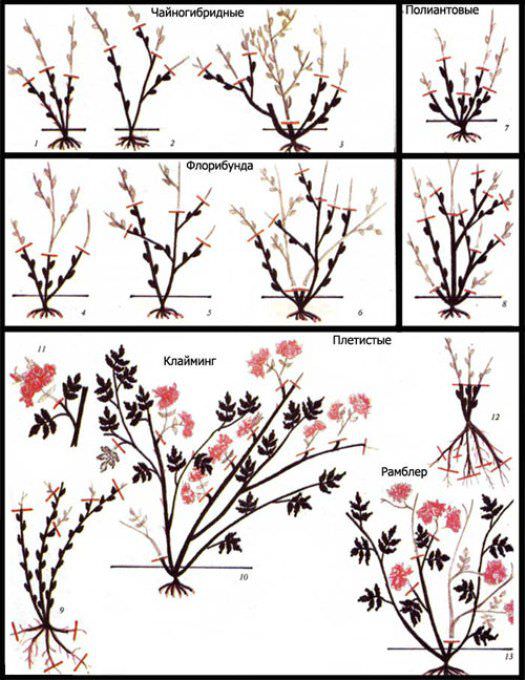

Park roses
The park rose has flowers laid on the branches of the previous year and this one. Pruning in the fall will stimulate the growth of new shoots. Weak, unhealthy branches are removed. Forming the skeleton of the bush, the main branches are cut to 15 cm.
Climbing roses
Climbing varieties are pruned in order to completely cover the required object, form the desired crown, and ensure long flowering.
Climbing varieties are divided into two types:
- Small-flowered Rambler
have long (up to 4 m), thin, flexible shoots, as well as large inflorescences of small flowers blooming on the shoots of the last year. These shoots do not bloom again. Therefore, after flowering, they are cut off to the base of the soil, 3-4 new shoots grow from the soil to replace them. In autumn, Rambler are not drastically pruned, removing only leaves, remnants of inflorescences, damaged branches. - Climbers
- the second group, the shoots of which are thick, strong, up to 2.5 m long. They bloom once a season. They differ from Rambler by the formation of several basal stems, and they bloom due to growths on old shoots. In autumn, weak stems are removed, and young shoots up to 4 years old are left. It is best to leave 3 new replacement shoots and up to 7 old, flowering stems.
Semi-twisted roses
Semi-plaited varieties bloom on this year's growth. In autumn, one-year growth is shortened by a third. Two-year branches are shortened to 3-5, their growth is up to 1-2 buds.
Stamp types
When floribundas or hybrid tea are grafted on the stem, the crown will grow upward. They are cut in autumn, each growth is up to 3-5 buds, lateral growth is up to 1-2. The middle of the stem must be left free.
Standard roses with a weeping crown are pruned, removing all last year's stems, leaving only the current growth. When it is not enough, you can leave symmetrical biennial stems, cutting off their lateral shoots to 3 buds.
Ground cover roses
In autumn, if the bush was planted in spring, remove all the stems that have faded. For future flowering, basal processes are left, slightly cutting and bending the stems to the ground, fixing in this position. This will ensure flowering along the entire length of the pagon. Lateral growths are cut off, leaving 2-3 buds.
In the fall, in the second year, half of the pinned branches are removed. New sprouts are taken from the middle and attached to the soil. Lateral shoots are removed, leaving 2 - 3 buds. All processes that interfere with growth are removed.
In the third and subsequent years in the fall, all branches attached to the ground are removed. New shoots are taken from the middle of the bush and pinned to the ground, cutting off the lateral shoots to 3 buds. Also remove all crossed stems, diseased, immature, damaged.
Autumn pruning of roses is very important and should not be neglected. The future flowering, as well as the appearance and health of the bush, depends on the quality of pruning. Take the time for these noble plants, the result of your efforts will be a violent, long flowering.
Indoor rose loves light, nutritious soil and fresh air. With proper care, it will bloom for several months in a row, and with the help of pruning, you can form both a bush with a large number of small flowers, and large single ovaries.
Indoor roses can be pruned in both autumn and spring, depending on the purpose. After such a procedure, the rose rejuvenates, and with a new period of activity it is able to bloom again magnificently. If the rose is not cut off, a large number of shoots appear, the bush thickens and the flowering stops.
Fast navigation through the article
Faithful care for indoor roses in pots: the video explains in detail all the nuances
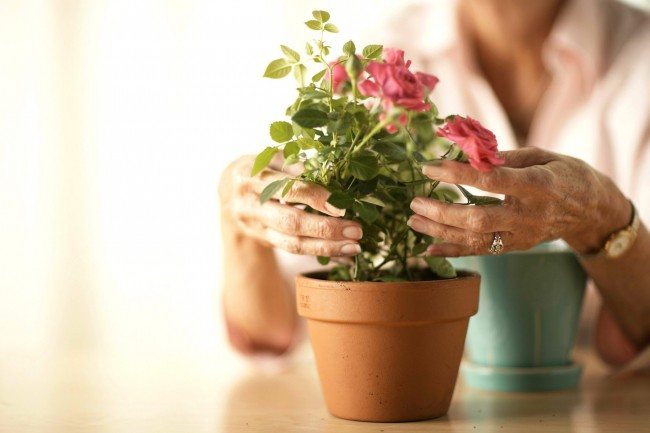

It is very important first to finally figure out how to grow a rose at home in a pot, and only then get down to business, so as not to ditch such a magnificently beautiful plant, which for many years could delight the family with its incredible aroma, as well as a very beautiful appearance. ... However, you can transplant a rose you just bought in a store only when this new "inhabitant" of your windowsill finally gets used to it and gets used to it.
Preliminary preparations: how to grow roses in a pot at home
In order to properly transplant your new friend, you will have to consider a few simple but extremely important conditions that will undoubtedly lead you to success. And only after that you will have to apply the knowledge of how to care for indoor roses in a pot, and before that, while the plant is in the storey soil, apart from watering and spraying the leaves, it is not at all recommended to do anything with it.
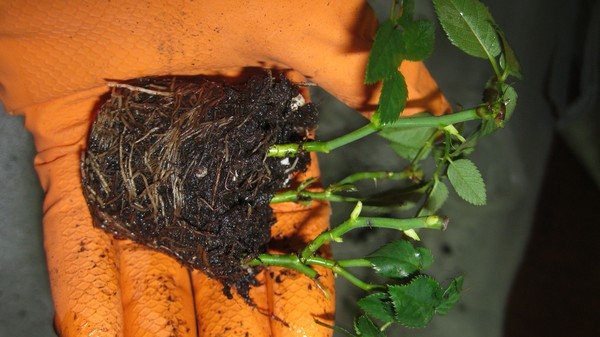

- All flower growers, together with gardeners, know for sure that the phases of development and growth of plants are inextricably linked with the phases of the moon, therefore, this is exactly what will have to be guided by. It is better to transplant a rose when the luminary is in a growing phase, and it is better not to do this on a waning moon.
- It is worth preliminarily, before transplanting, slightly moisten the roots of the plants. Moreover, everything will need to be done very carefully so as not to damage the roots, if possible. It is best not to touch the clod of earth or peat at all, in which the roots are located, but to transfer the plant along with it.
- To transplant a rose, you need to acquire a special soil that will allow the plant to feel comfortable. Moreover, you can do it yourself, this will require four parts of the land, as well as high-quality humus, and one part of a simple river sand.
The right pot is important
In order to understand how to care for roses in a pot, you first need to understand what it should be like, what materials should you choose the product from, and what should be taken into account even before transplanting. In fact, everything will not be difficult, however, patience and work will still have to be applied.
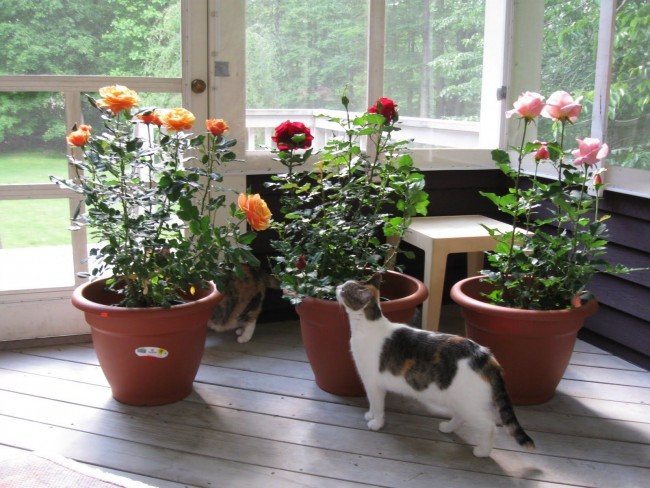

The pot should be slightly larger than the store one, but not too much, otherwise the rose will simply not bloom. It is optimal to choose a pot made of ceramics, and before transplanting, it will need to be soaked in warm water for about a couple of hours. But this is new, and if something has grown in it before, then it is better to wash it thoroughly with a stiff brush, but never use detergents or cleaning agents.
Never, in any case, do not use any household chemicals with respect to a room, decorative rose, because this is the certain death of a plant, without options. This flower is so delicate and whimsical that even washing the transplant pot with detergent, you are already making an irreparable mistake.
- Drainage should never be forgotten. It can be made from expanded clay or rather fine gravel, river or sea pebbles. However, it should be understood that if you did not buy the stones in a flower shop, it is better to bake them for about twenty minutes in the oven, as well as all the soil from the street, in order to kill germs and bacteria, and parasites together with them.
- It is also important that the pot has a hole in the bottom, otherwise the roots will rot due to excessive moisture.
- Transplant the rose into a pot and remove it for a day in a shady, ventilated place, for example, on the balcony, you can cover the flower with a newspaper or a light cloth.
- After this time, the rose must, on the contrary, be taken out to a bright place, and avoiding drafts, as well as direct sunlight, especially falling through the glass.
Common types
Bengal rose
This is perhaps the most common variety of indoor roses. The Bengal rose is absolutely unpretentious, it differs in that it does not shed its leaves after flowering. Flowers are odorless. Does not require pruning, except for dried or diseased branches.
Miniature rose
The bushes are no higher than 30 cm, the flowers are collected in inflorescences and have a delicate aroma. Flowers can be white to black. Differs in abundant flowering and does not need pruning.
Baby Carnival
It is characterized by abundant flowering, perfect for both rooms and garden borders. This yellow indoor rose is always loved by flower growers.
Pixie
This variety is distinguished by two-colored double flowers - white with a pink center. It blooms profusely and for a long time, reaches a height of only 20 cm.
Eleanor
More common in the south. Bushes 30 cm tall are covered with coral flowers. The flowers themselves are collected in inflorescences of 10-15 pieces.
As a reference, do not confuse miniature indoor roses with Chinese indoor roses. The latter has nothing to do with roses and is called hibiscus.
A few more useful tips for caring for a beautiful rose:
- Remember, the rose will be bad both in too close and in a very spacious pot. When transplanting, take a container slightly larger than the previous one, and when planting consistently increase the size of the pot
- When planting and transplanting, you can add special granules to the substrate that will prevent the roots from rotting and rotting.
- The smaller the pot, the more often the rose should be watered (the soil dries out faster in a small pot).
Problems, diseases and pests in the flower
Problems with a room rose can arise due to improper care. The reason for the lack of flowering can be:
- Eating disorder
- Increased acidity of the soil
- Lack of lighting
- Incorrect transplant
- Drafts
Of the diseases, the rose can be affected by chlorosis, which is treated with iron chelate. The yellowing of the plant indicates its defeat by the fungus. In this case, you need to treat the rose with a fungicide.
The same must be done with powdery mildew (white bloom on the rose).
Of the pests, the indoor rose is most often affected by the spider mite (a thin web appears between the leaves). A spider mite on a room rose can lead to viral diseases. You need to treat the flower with Apollo or Fitoverm preparations.
Thrips or aphids on indoor roses are no less a threat. They infect buds and leaves, deforming them. It is treated with insecticidal preparations for indoor plants.
Pruning before, during and after flowering - what's the difference?
- If the rose has large flowers, then when pruning, you must leave at least 3 buds on the branch. If the rose does not bloom profusely or does not bloom at all, then pruning will help rejuvenate it and activate the process.
- If you remove only weak shoots of the plant and do not touch the upper part, then a slender single rose will grow in the grower. If the plant has already bloomed, then it's time to remove the dry buds so that the power of the rose does not go to them.
- For further propagation of a room rose, you can cut cuttings from that part of the plant, the flowers of which have faded. A stalk with 2-3 buds is suitable for this.
Important! If you have old rose bushes, you don't need to prune them. It is enough to domesticate them a little and remove dead plants.
Transfer


Growing an adorable shrub at home
In order for the home rose to bloom violently in the spring, the transplant must be carried out already in August, this will allow the roots to adapt and take root well. Otherwise, the rose will take root during the entire period of rapid growth and will bloom only by autumn. When transplanting a plant, you need to try not to destroy the earthen lump, since the rose is very sensitive to root damage and then gets sick for a long time.
A room rose should be planted in small pots, since with an overabundance of space in the flowerpot, the rose will give a lot of greenery and rarely bloom.
Let's summarize
- In order for a rose in a pot to bloom for many years, it must be constantly pruned. In addition to removing problem branches and wilted buds, you need to carry out the main pruning, preparing the bush for the new season.
- The main pruning of the bush is carried out at the end of winter or at the very beginning (literally in the first week) of spring. The bush needs to be cleaned of problem or diseased branches, and healthy ones should be shortened, encouraging the emergence of new shoots. It is on the young growth of the rose that the buds are tied.
- You should also prune for the winter, after the end of flowering, remove all sluggish buds.
Additional Tips
A multi-colored dwarf rose with large buds should be cut by 3-5 eyes in spring. The small-flowered dwarf rose gives abundant flowering if it is cut by 2-3 eyes. With a short break, it will bloom until the end of the growing season.
After cutting, the indoor rose is immediately brought into a room or room with a temperature of no higher than 10-12 ° C (you can put the plant in the basement for a while). This is necessary in order for the eyes to be able to germinate slowly. As soon as the first leaves appear, the plant can be transferred to a sunny place.
All new shoots from the rose must be cut at the base, so they will not take away micronutrients from the bush and will not stop its development.If you do everything right, powerful shoots and beautiful buds will soon appear on the bush.
Pruning is desirable during the growth phase of the moon. If the roses are not pruned before winter begins, the flower will bloom less lush the next year and the plant may look a little sluggish. To prevent this, pruning should be done in early spring.
Immediately after purchasing a room rose, you should not rush to pruning. Wait 2-3 weeks, give the plant time to adapt to new conditions. Thoroughly disinfect the entire instrument with an alcohol-based cleaner before trimming. Pruning indoor roses is not at all difficult, but if you doubt whether you can do everything right on your own, it is better to do the pruning with a specialist for the first time. Having received the necessary skills, you can easily independently apply this technique on indoor roses and other plants in your home.
www.dom-
What care does the Cordana rose require after purchase?
Many probably succumbed to the temptation to purchase a miniature rose in a pot. This is a Cordana rose, after purchase for which care has a number of features. Lush greenery and varied colors of numerous flowers made it a favorite among lovers of miniature roses. Reaching a height of only 30 cm, Cardana looks no different from ordinary roses. The only difference is the completely missing aroma. But, on the other hand, allergy sufferers can grow such roses. In stores, they are sold in 3-4 bushes in a pot, bloom from May to October.
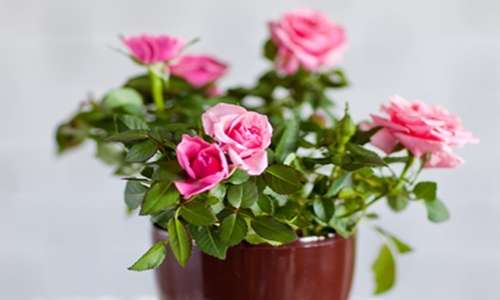

Rose Cordana is distinguished by lush and long flowering.
Before buying such a rose, be sure to carefully examine the bushes. The leaves should be smooth and shiny. The presence of spots indicates the presence of fungal or bacterial diseases, and the yellowness of the leaves begins with improper care. There should be no insects on the plant. Outwardly, the flower should look healthy, with no signs of wilting.
How to trim?
The cut should be oblique in relation to the kidney and be at a certain distance from it. The optimal distance between the kidney and the cut is approximately 1 cm. It should not be too sharp (a 45-degree slope is better) and should be done in the opposite direction from the kidney. And the last thing: the tool must be well sharpened, then the cut will be clean, without burrs, which often contribute to the reproduction of pathogenic organisms.
You need to remove all dead, damaged and tangled branches that interfere with the development of the middle part of the bush. Full pruning involves shortening all branches to stimulate flowering and give the plant the desired shape and size.
It is imperative to remove all wilted flowers. The fact is that the energy that a plant spends on wilted flowers is not used to give birth to new flowers.
Answers to readers' questions
This plant is perennial and, with good care, lives a long time.
Is this flower poisonous?
Indoor rose is not a poisonous plant.
Why doesn't the rose bloom?
In the previous chapters, situations were described when a rose stops blooming or does not bloom at all. This may be due to a violation of the maintenance of the plant, as well as exposure to pests. It is necessary to examine the flower. If no pests are observed, you need to change some care parameters and observe the plant.
Why does the indoor rose dry (wither)?
If the plant withers and the buds fall off, it means that it lacks watering. If this continues with normal watering, look for signs of disease or pests.
How does the plant overwinter?
The best wintering for a room rose will be a balcony with a temperature not higher than +15 degrees. This is a dormant period for the plant, so watering is minimal and fertilizing is needed.
Growing indoor roses is a troublesome and painstaking business.However, a bush that blooms in exuberant color on its own windowsill is a pride for any grower. In order for the plant to bloom well and tolerate wintering normally, it is necessary to cut it off in a timely manner and correctly. After this procedure, new side shoots are formed, which means additional pink buds. A pruned room rose bush not only looks beautiful and neat, but also rejuvenates in this way.
Check out the characteristics of this indoor rose variety - the depth and frequency of pruning of a domesticated plant may depend on varietal differences. For example, in a Bengal rose, small shoots without flowers are only pinched, and in a hybrid tea, they are pruned by 3-4 eyes. The main principle of pruning roses is as follows: if they do not bush well and form long single shoots, then it is necessary to do regular pinching of the tops for the development of lateral branches. In this case, the bush is formed to the taste of a florist.
Choose the right time to prune your home roses. It is believed that the best results are obtained by processing plants in late March-early April, when they have successfully overwintered, but have not yet blossomed buds. Timely pruning of the shoots accelerates the flowering of the rose bush.
Pruning roses must be done with an exceptionally sharp knife so that the cut is by no means torn - otherwise the plant may die. In addition, you need to cut the shoots of roses at a slight slope and half a centimeter above the bud. It must be excluded that water can run off during irrigation from the cut made, therefore the oblique line should be directed only in the direction of the peephole!
Start by thinning the rose bush. Remove old, damaged and frostbitten twigs; on a weak plant, only shorten the shoots by one eye. On a bushy, healthy rose, it is necessary to cut off all weak processes growing inside the bush; if the shoot lacks an apical bud or is too curved, it must also be removed.
Proceed with the basic pruning of the room rose. Here you need to pay attention to the following points:
- If the rose bush has large flowers, leave 3 to 6 buds on each shoot; at the same time, shorten the strong branches only slightly, and make the weak ones shorter;
- When a rose does not bloom well, it is also necessary to rejuvenate it with the help of deep pruning; remove all old and diseased wood;
- If you are growing single plants, limit the pinching of the tops. In this case, you only need to remove the weakest shoots, cut healthy ones in moderation.
When your house roses have faded, cut off the wilted flowers so that they don't weigh down the branch - then a well-groomed plant will open its buds faster the next time.
Planting methods
Planting a room rose by cuttings.
Optimal planting time
The best time to plant a room rose is from May to September.
Plant soil (Soil composition)
A potted rose requires a nutritious, breathable soil. It is best to use ready-made primer by purchasing it in a store. The optimal composition of the soil for a plant is sod and humus of the earth, sand in proportions of 4: 4: 1, respectively. Loosening the soil is not recommended because of the danger of damaging the roots. Rose prefers neutral soil.
There are some features in the care that are characteristic of this particular indoor plant.
Location and lighting for the plant
The rose needs fresh air, so the ideal placement for her is a balcony or a garden bed in summer (you can take her with you to your country house if you spend there all summer). However, it is not recommended to leave it unattended, because it requires frequent watering in summer during the flowering period.
At home, the rose is best placed on the southeast or south side, because it loves a lot of light. In the fall, when the daylight hours are short, she needs to turn on additional lighting from a fluorescent lamp. This is done to extend the flowering period.
In winter, during the rest period, a comfortable temperature for a rose is +10 - +12 degrees. If there is an opportunity to put it on a glazed loggia or balcony, it will have a good rest. Indoor winter temperatures are not very suitable for her. If it is not possible to keep the flower at a low temperature, you should protect it as much as possible from the heat of the batteries and dry air.
It is advisable to turn a pot with a miniature room rose from time to time to the light in different directions.
Important!
If the rose hibernates on a glazed loggia, in order to avoid freezing of the soil, the pot with the plant can be put in a box and sawdust sprinkled around it.
Air humidity
Indoor mini roses need high humidity. When they are outside (on the balcony or in the garden), additional moisture is not required. In winter, if the rose is in the room, it is better to keep the pot with it in a tray with damp pebbles.
The rose needs weekly water sprays. If the room is cool in winter, it is better not to spray the rose. If the air is too dry and warm, spraying should be carried out 1-2 times a week, even in winter.
Never spray the rose during the day in hot summer weather.
Important!
In a dry atmosphere, pests can appear on the flower.
Temperature regime for a flower
The most comfortable temperature for a rose in the summer is +14 - +25 degrees. In winter, the rose needs coolness - no higher than +15 degrees.
How to water properly
Indoor rose does not tolerate both drying out and excessive watering. In the summer, when the rose blooms, watering is necessary 2 times a day - in the morning and in the evening. Watering is necessary with settled water at room temperature.
In autumn, when the rose sheds its leaves, watering should be reduced to 1 time per week if the rose hibernates on the balcony. If it is in a room at a fairly high temperature, it should be watered as the topsoil dries out.
You can alternate top and bottom watering (watering the soil and filling the pan). In any case, excess water from the pallet must be drained to avoid root rot.
In the spring, as the plant awakens, watering should be gradually increased.
Fertilizing and fertilizing a rose flower
Due to the long flowering, the rose loses strength and needs fertilization of the soil. They begin to feed her towards the end of February 1 time in 10 days. It is recommended to alternate mineral fertilizers with organic ones.
If you just transplanted a flower into fresh soil, you do not need to fertilize it.
Important!
Before fertilizing, the flower must be watered with warm water.
Pruning the mini rose is necessary in order to stimulate the ovary. During the flowering period, it is imperative to trim the wilted flowers as short as possible.
The flower is routinely pruned in the fall in preparation for the dormant period. You can also do this in the spring.
Pruning methods
Pruning must be done with a sharp tool so that no torn parts remain on the branch, this can lead to the death of the entire plant. Trim the branches to healthy tissue, above the bud, which is facing outward. An oblique cut is made about five millimeters above the kidney.
It is necessary to remove all weak or dry shoots, as well as those that do not have an upper bud. When two shoots are intertwined, one of them is removed. If, after pruning, two stems appear from one bud, the extra ones must be cut off.
Important!
Spring pruning should not be carried out until at least 10 hours of daylight has arrived, otherwise young shoots will not be able to fully develop.
Notes to the florist
Indoor rose differs from the usual one in its miniature size. Its bushes reach a height of no more than 35-45 cm. The flowers of a potted rose are very beautiful, small, of various colors, they can be fragrant or odorless. Dutch or Danish roses in pots are often sold in Russia. As a rule, potted roses are sold already in bloom. The healthy plant has succulent green leaves without painful-looking spots or damage.The leaves must be elastic, stick well to the stem and not fall off! In no case should black areas be observed on the stems! When buying, you need to take a good look at the flower: a large number of buds are approved, but they should not be opened! Be sure to remove the gift wrapping and take a close look at the leaves and stems.
Most roses are kept in refrigerators when sold. Getting into a warm apartment, the plant is stressed, for acclimatization, they should be kept indoors at a temperature in the range of 15-18 ° C.
The best time to buy roses is during the cold season, from autumn to spring. It is best to purchase this houseplant in February and March. Potted roses prefer:
- sunny side in the house; it is necessary to choose southern windows or southeast windows;
- enriched soil;
- free access of fresh air during a hot period;
- good watering;
- top dressing at least once a week during active growth and flowering;
- transplant into a spacious pot from a cramped one.
Flowers do not like:
- excessive heat;
- withered flowers on the plant;
- cold water for irrigation;
- pests and diseases;
- injury to the root system during transplantation.
Formative
Undercutting for molding is optional. Some people prefer a strict shape, for example, in the form of a cone or a ball. If you cut the height, the rose is low and the bush is flat.


Also, the formation depends on the variety of the crop. Chinese or floribundas can be cut in different ways, but elliptical, conical and spheroidal shapes are suitable for miniature varieties.
If you bought an adult rose, then to change the shape, you need to shorten and cut the side shoots gradually, the desired shape will turn out in two years. Thanks to such slow actions, the flower is given time to regenerate and thicken the crown.
Conditions for keeping a flower
Rosa Cordana loves sunlight, but you need to avoid burning the foliage.
Lighting. Rose is very fond of the sun. The best place for her will be the southern windows. Avoid leaf burns during peak solar activity.
Temperature.
The most comfortable temperature range is 15 ° -20 °. Loves airing, no drafts.
Watering must be plentiful and regular. In no case should moisture stagnation be allowed, so excess water from the sump must be drained. Test the soil for moisture with your finger before the procedure. Do not allow acidification of the soil. Water is required warm and settled. Remember that well-organized watering will promote long-lasting and abundant flowering.
Although many sources recommend spraying, experienced growers believe that it contributes to the occurrence of rose diseases. When properly watered, it thrives in a standard home setting without additional moisture.
Rose is very positive about feeding. During the period of active growth, it should be watered about once a week with liquid complex fertilizers.
Transfer is the best way to transplant Cordana roses.
Pruning rules. Withered flowers are pruned, which stimulates the appearance of new ones. Before wintering, the plant is completely pruned. Unlike a garden rose, Cordana never produces unnecessary growth. Young shoots must be preserved because they will gradually replace the old ones. They are cut off together with adult branches, leaving 3-4 buds. It is also necessary to remove all crooked, frail and thickening shoots.
Rest period. This is the most difficult time for a flower. In the dry air of the heated room, the rose sheds part of the foliage and almost stops flowering. Therefore, the plant must be allowed to rest. For this, the indoor beauty is cut off, watering is minimized and placed in a cool place with a temperature of 5 ° -8 ° for "deep sleep". In February, the rose needs to be taken out to its usual place, gradually increasing the watering.
Reproduction. The most affordable way is cuttings from May to August.To do this, cut the branches, which have 3-4 buds? and place in a glass of water, adding a growth stimulant. The roots should appear in a couple of weeks. When they are 2 cm tall, plant the cuttings in separate pots. This method of reproduction allows you to achieve flowering in a young bush in a month.
Rose Cordana is a plant with a very capricious character.
She can get sick when changing places, drop all the buds if they forgot to water. But for the attentiveness and diligence in relation to himself, he will reward the owner with an unforgettable flowering for 7 months.
Share a useful article:
Similar articles:
And a little about the secrets of the Author
Have you ever experienced unbearable joint pain? And you know firsthand what it is:
- inability to move easily and comfortably;
- discomfort when going up and down stairs;
- unpleasant crunching, clicking not on their own;
- pain during or after exercise;
- joint inflammation and swelling;
- unreasonable and sometimes unbearable aching pain in the joints ...
Now answer the question: does this suit you? How can you endure such pain? And how much money have you already "poured" on ineffective treatment? That's right - it's time to end it! Do you agree? That is why we decided to publish an exclusive interview with Oleg Gazmanov, in which he revealed the secrets of getting rid of joint pain, arthritis and arthrosis.
Attention, only TODAY!
Varieties of roses blooming indoors
If you are confused and do not know which plant will take root better in the room, we will conduct a short excursion to the varieties of decorative roses.
Miniature types of roses:
- Baby Darling;
- Yellow Doll - yellow;
- Angela Rippon;
Tea-hybrid fragrant:
- La France;
- Jules Boucher.
Multi-flowered polyanthus roses:
- Triumph;
- Clotilde.
Bengali:
- Ophelia;
- Grothendorst Pink.
All of the listed varieties more or less adequately adapt to indoor conditions. These plants still grow better outdoors in a flower garden, since the dry air in the room does not favor the growth of these delicate flowers. And with frequent transplantation, you can accidentally hook the root and harm the flower.
But if it is not possible to transplant low-growing roses into open ground, then you need to create the most favorable conditions for their development in our apartment environment.
How to ensure plant adaptation after purchase
The first 2-3 weeks will be the most difficult for the flower. Getting used to a new place, he can shed all the leaves and buds. But with proper care, after about a month, the plant will bloom again.
To surely get rid of possible pests, immediately after purchase, wash the rose under a warm shower and treat it with a special universal preparation.
It is better to transplant a non-flowering or dying rose. The most gentle method for this is transshipment. This will keep the roots intact. The soil in the pot should be nutritious, with good drainage. After planting, treat the plant with a growth stimulant. If you purchased a pot with several shrubs, plant them.
In what cases is it applied?
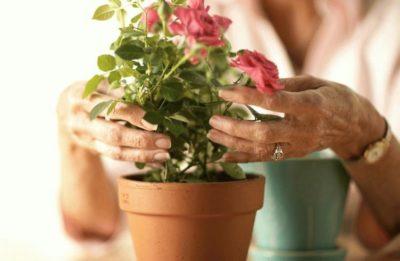

It is useful to prune young bushes or carry out so-called sanitary pruning. It is better to produce it in spring or autumn. With this pruning, damaged, dead or simply weak branches located closer to the main stem of the flower are removed. In addition, formative pruning can be carried out, in which the plant is formed into the desired shape. Pruning is also carried out to rejuvenate the flower, which is necessary in order to restore vitality to the grown bush.
If you need to form a plant with one trunk and a dense top, then the shoots in the lower part and on the sides should be removed to the base. For even growth of shoots, the top of the plant can be pinned.
Features of holding at different times of the year
In the spring
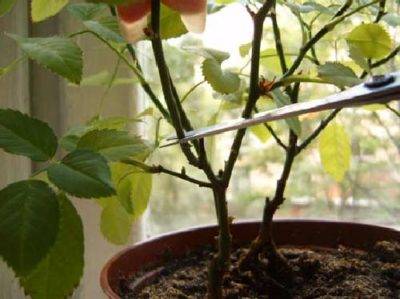

The flower of the Chinese Rose is formed at the very top of the shoot (young), it turns out, the more our plant begins to bush, the more magnificently it will bloom... Therefore, you do not need to be afraid to remove the excess, the bush, after pruning, will release many new shoots and twigs, at the ends of which buds will form.
However, there are still some limitations - it is undesirable to cut more than 2/3 of the total plant volume. It is important to decide on the desired shape of the bush before starting the procedure, and not in the process, in order to avoid mistakes. The cut should be above the outward-facing bud, and the cut should be at a 45-degree angle.
In the spring, a complete pruning of the bush is usually carried out, that is, all branches are shortened by 2/3. It is imperative to remove all "tops" growing parallel to the main stem and branches that grow inside the crown.
In autumn
It is carried out after the flowering is completely completed, you need to shorten all the branches that have bloomed. Usually, formative pruning is carried out in the fall, that is, 1/3 of the length of the branches. If you are growing a small plant and do not want it to grow up, then you will have to shorten the entire crown - all branches.
All broken and diseased branches are removed (if any), it is also necessary to remove tops if they reappear. There is also such an option - in the fall, you can cut the plant to a hemp (leave approximately 5 cm) and remove it in a cool place in the shade, and in the spring it will begin to grow rapidly.
Pruning old and new plants - is there a difference?
Of course, there is a difference between pruning an old adult plant and a new young one, let's take a closer look.
- Pruning a new plant - a young new bush requires gentle pruning, which is called pinching. Indeed, for such a plant, it is not yet necessary to carry out serious pruning to stimulate the growth of new young shoots. In a young bush, it is necessary to pinch the very tips of all branches above the upper bud and this will be enough.


Pruning an old plant - it needs a more radical pruning - or shortening all shoots by 2/3 parts, or in some cases the Chinese Rose is almost completely cut off, leaving a small stump (in the fall). but from such a hemp, one might say, from the roots, a new strong plant grows - such a unique ability is possessed by the Chinese Rose. Thanks to pruning, the old bush undergoes a rejuvenation procedure, a powerful impetus is given for the growth of young shoots and the quality of flowering increases.
Follow-up care
After completing all the manipulations, the Chinese Rose can be sprayed with Epin for easier adaptation. And then we take care of it as usual, we provide the conditions necessary for its successful growth and flowering.
- Watering - when active growth or flowering occurs, then abundant watering is needed so that the soil does not dry out, the top layer only slightly dries out. In cool weather (autumn - winter), watering is not needed so often, but the soil in any case should not dry out, water it about once a week. Only soft, settled water is suitable for irrigation.
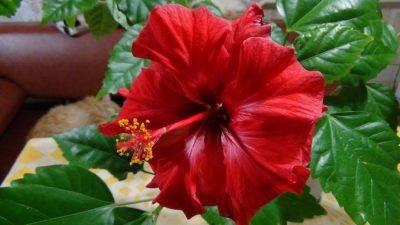

Humidity - you need to maintain air humidity of about 45 - 50%, for this you can put a fountain next to the bush or just a vase of water. It is also necessary to constantly spray the plant, only with soft and warm water, periodically rinse it under the shower, the leaves must be clean from dust.- Top dressing - it is very good to use complex, such as "Rainbow", you need to make approximately once a month, and during flowering 2 times a month.
- Temperature - in summer, the desired temperature for the plant is 20 - 25 degrees, and in winter it is necessary to maintain about 18 - 16 degrees. The Chinese Rose does not like drafts, it is necessary to ventilate the room, an inflow of fresh air is required for the flower, but exclude the ingress of wind (especially cold).
- Lighting - you need good, better on the east window (or west), the light should be diffused, shade from the direct rays of the sun.In the summer, it is very useful to take the flower out to the balcony, in the fresh air.
Watching a video on the topic: "Caring for a Chinese rose at home"


